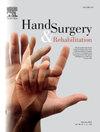梯形跖骨关节成形术中梯形近关节表面(PAST)和梯形关节表面(TRAST)解剖对冠放置的影响
IF 0.9
4区 医学
Q4 ORTHOPEDICS
引用次数: 0
摘要
斜骨手骨假体是解决斜骨手骨关节炎的手术选择之一。几位作者报道了托杯和骨托位置的重要性,以尽量减少松动的风险。最近,Athlani等人认为,杯子应该放在四边形宽度的中间。本研究的资深作者观察到,由于杯子与梯形关节面(TRAST)之间的撞击(早期接触),特别是当梯形高度较低时,将杯子放置在梯形宽度的中间并不总是可能的。本研究的目的是分析斜方近端关节面(PAST)和TRAST解剖对杯子放置的影响,以改进斜方腕关节置换术的术前计划。回顾性评价56例接受斜骨骨关节炎手术的患者术前正位x线片,分析过去和特拉斯特的解剖结构对斜骨手关节置换术中假杯放置的影响。计算了过去体覆盖假体杯的百分比和梯形的可用高度。斜方的可用高度对应于假杯近端尺侧缘切骨后的斜方高度;这是考虑到过去和特拉斯特的解剖结构计算出的最小的四边形高度,杯子放在四边形宽度的中间。在39%的病例中,存在显著差异(平均4.5 mm, P <;0.001),在四边形的径向高度(通常考虑)和四边形的可用高度之间。当斜方体高度较低时,PAST和TRAST的解剖结构对假体杯的放置有影响。本研究的结果表明,所有的手术者都必须了解这些考虑因素;应该考虑侧化、种植体悬吊或其他手术选择,以防止一些手术内和术后并发症。本文章由计算机程序翻译,如有差异,请以英文原文为准。
Influence de l’anatomie de la surface articulaire proximal du trapèze (PAST) et de la surface articulaire trapézoïdienne du trapèze (TRAST) sur le placement de la cupule durant l’arthroplastie trapézo-métacarpienne
Trapeziometacarpal prosthesis is one of the surgical options to address trapeziometacarpal osteoarthritis. Several authors reported the importance of the position of the cup and of bone stock to minimize the risk of loosening. Recenlty, Athlani et al. argued that the cup should be placed in the middle of the width of the trapezium. The senior author of the present study observed that placing the cup in the middle of trapezial width is not always possible, due to impingement (early contact) between the cup and the trapezoidal articular surface of the trapezium (TRAST), especially when trapezial height is low. The objective of the present study was to analyze the influence of the proximal articular surface of the trapezium (PAST) and TRAST anatomy on cup placement, in order to improve preoperative planning for trapeziometacarpal arthroplasty.
The influence of the anatomy of the PAST and the TRAST on cup placement during trapeziometacarpal arthroplasty was retrospectively evaluated on 56 preoperative anteroposterior radiographs of patients who underwent surgery for trapeziometacarpal osteoarthritis. The percentage coverage of the prosthetic cup by the PAST and the available height of the trapezium were calculated. The available height of the trapezium corresponds to the trapezium height after the bone cut at the ulnar edge of the proximal end of the prosthetic cup; it is the smallest available height of the trapezium witch was calculated considering the anatomy of the PAST and TRAST, with the cup placed in the middle of the width of the trapezium.
In 39% of cases, there was a significant difference (up to a mean 4.5 mm, P < 0.001) between the radial height of the trapezium (which is usually considered) and the available height of the trapezium.
The anatomy of the PAST and the TRAST has an impact on the placement of the prosthetic cup when trapezium height is low. The results of the present study suggest that these considerations must be known by all operators performing trapeziometacarpal arthroplasty; that lateralization, implant suspension, or surgical alternatives should be considered to prevent several intra- and postoperative surgical complications.
求助全文
通过发布文献求助,成功后即可免费获取论文全文。
去求助
来源期刊

Hand Surgery & Rehabilitation
Medicine-Surgery
CiteScore
1.70
自引率
27.30%
发文量
0
审稿时长
49 days
期刊介绍:
As the official publication of the French, Belgian and Swiss Societies for Surgery of the Hand, as well as of the French Society of Rehabilitation of the Hand & Upper Limb, ''Hand Surgery and Rehabilitation'' - formerly named "Chirurgie de la Main" - publishes original articles, literature reviews, technical notes, and clinical cases. It is indexed in the main international databases (including Medline). Initially a platform for French-speaking hand surgeons, the journal will now publish its articles in English to disseminate its author''s scientific findings more widely. The journal also includes a biannual supplement in French, the monograph of the French Society for Surgery of the Hand, where comprehensive reviews in the fields of hand, peripheral nerve and upper limb surgery are presented.
Organe officiel de la Société française de chirurgie de la main, de la Société française de Rééducation de la main (SFRM-GEMMSOR), de la Société suisse de chirurgie de la main et du Belgian Hand Group, indexée dans les grandes bases de données internationales (Medline, Embase, Pascal, Scopus), Hand Surgery and Rehabilitation - anciennement titrée Chirurgie de la main - publie des articles originaux, des revues de la littérature, des notes techniques, des cas clinique. Initialement plateforme d''expression francophone de la spécialité, la revue s''oriente désormais vers l''anglais pour devenir une référence scientifique et de formation de la spécialité en France et en Europe. Avec 6 publications en anglais par an, la revue comprend également un supplément biannuel, la monographie du GEM, où sont présentées en français, des mises au point complètes dans les domaines de la chirurgie de la main, des nerfs périphériques et du membre supérieur.
 求助内容:
求助内容: 应助结果提醒方式:
应助结果提醒方式:


